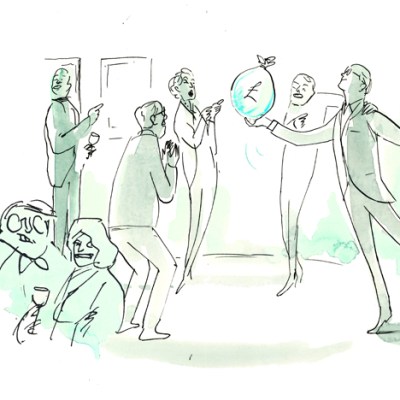This book arrives in advance of a swathe of publications, which, in 2019, will celebrate the centenary of the Bauhaus, the German art school that created the model for a modern approach to the teaching of fine art and its relation to architecture. Josef Albers (1888–1976) was a key figure within the Bauhaus, supportive of, yet often at odds with, its first director Walter Gropius. It will be interesting to read Fiona MacCarthy’s soon-to-be-published biography of Gropius alongside Charles Darwent’s account of the Bauhaus, which is here viewed chiefly from Albers’ perspective, in the most fascinating section of the book. For Darwent has created an engaging portrait, not only of an endearingly difficult, determined man, but also of the artistic climate as it changed according to time and place in the course of Albers’ long life.
His story begins in Bottrop, a small town in a coal-mining area in Westphalia. The town’s air was thick with coal dust, and in later life Albers recollected that as a boy even his spit was black. What he did not mention to others was that he had been born into a Roman Catholic family. At that time Protestant Prussia was intensely anti-Catholic and openly anti-Rome in the wake of the First Vatican Council that, in 1870, had pronounced the Pope infallible. This may explain the reticence that obscured Albers’ faith for, like Andy Warhol (another Catholic), he kept quiet about his spiritual life. It surprised many at Albers’ funeral to find the service conducted in accordance with Catholic rites, as he had requested.
There are other surprises. Albers began as an elementary school teacher and might not have become an artist if he had not been granted leave to study at the Royal Art School in Berlin. He became aware of modern French art and of two avant-garde German Expressionist groups, Die Brücke and Der Blaue Reiter, but seems to have learnt more at this stage from Van Gogh. Later he developed a loathing of all forms of Expressionism. ‘You might as well rub shit on canvas,’ he would remark of Abstract Expressionism while living in America in the 1950s. After moving on from Berlin to Munich’s Royal Academy of Fine Arts, a circular fell into his hands announcing a new school that had just opened in Weimar. ‘Let us create a new guild of craftsmen,’ it announced, ‘without those class distinctions that build an arrogant barrier between craftsmen and artist.’ It was this exhortation that took him to the Bauhaus.
Homage to the Square, Renewed Hope (1951), Josef Albers. Photo: Tim Nighswander/Imagining4Art; © 2018 The Josef and Anni Albers Foundation/Artists Rights Society (ARS), New York/DACS, London/VG Bild-Kunst, Bonn

Darwent is sharp on the disappointments that Albers encountered. He took an instant dislike to Johannes Itten, who had become the dominant figure while Gropius battled for the survival of the art school with Weimar’s unsympathetic right-wing government. Poverty was endemic. The students dragged coal from the mines to the Bauhaus themselves and generally had to share in the work of keeping the place going. When Marcel Breuer arrived the first thing he found was a note pinned to a door with his name on it, telling him to sweep the room. It was Albers who handed him the broom. After Theo van Doesburg visited Weimar, bringing with him the ideas of De Stijl, the Bauhaus was turned on its head. Albers supported Gropius’s decision to move the school away from handwork and towards a more active relationship with industry, but there was little warmth between the two men.
Largely missing from this book, as Darwent acknowledges, is the story of Anni Albers, née Anneliese Fleischmann. She of course became the pre-eminent weaver in Europe, as the beautiful exhibition at Tate Modern has made clear (see Apollo, October 2018). The couple met at the Bauhaus, married in 1925, moved to America in 1933, stayed together for more than 50 years and remained deeply affectionate towards each other, despite Josef’s affairs, his habit of groping young women, jiggling breasts and signing his letters ‘your squeezer’. Anni was evidently cognisant of much, but how she dealt with this – while also enjoying a working partnership with Josef – has yet to be told.
Much of Josef’s work, even before he arrived at the Bauhaus, involved the use of glass. And his glass pictures and murals remain his most important works, aside from his famous series, Homage to the Square, on which he worked consistently for 25 years. Darwent’s introduction to this book is a helpful analysis of these inscrutable works, although their relationship to Malevich’s Black Square could be differently and further explored. Illustrations of the Homage series assist the introduction and appear again in several pages at the end of the book, making the reader further aware of its excellent design.
‘He taught you to see,’ said the Harlem painter Jacob Lawrence. These words summarise what many of Josef Albers’ students have put on record. Albers taught not only at the Bauhaus, but also at Black Mountain College in North Carolina and finally at the Yale School of Fine Arts. Informed that his tenure at Yale would end with the academic year 1957–58, Albers stayed on two years more, part-time and with no status. He had gone by the time Michael Craig-Martin arrived in 1961, but his famous colour course, and its complicated theoretical reasoning, was still being taught. Craig-Martin, who would become an influential tutor at Goldsmith’s as well as an internationally renowned artist, later realised that what he intuited at Yale, through the lingering presence of Albers and his ideas, ‘represented the summit of high-modernist art education’.
Josef Albers: Life and Work by Charles Darwent is published by Thames & Hudson.
From the December 2018 issue of Apollo. Preview and subscribe here.



